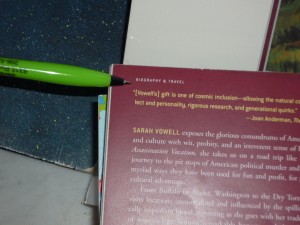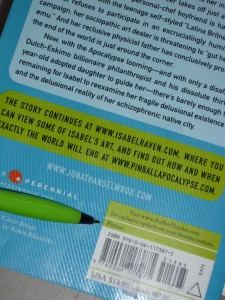
Sorry about the lapse in posting; I honestly meant to start blogging again a few days ago. I’ve been just exhausted.
To restate that more positively: I’m back from my fabulous writing retreat in the beautiful mountains of southwestern France — or to be precise, I wrote most of this post while I was on a plane from Zurich to Chicago. (Props to Swiss Air: the flight attendants had no problem with my co-opting three middle seats for a mid-air office. Much easier to use a laptop with your legs stretched out, I find, than folded underneath an unstable tray table. Oh, and they let you know that you’re about to land by offering you wee bars of chocolate.) Truth compels me to say, though, that I took this photo on the way to the retreat, not from it: those dark blobs are the Pyrenees.
If any of you map-huggers out there are thinking that I was neither retreating anywhere near Zurich nor do I generally reside in the vicinity of Chicago, you’re right: it took a van ride, two train trips, and three airplanes to get me from La Muse to Seattle.
Now that’s what I call retreated.
So if I still seem a bit jet-lagged, well, I’m entitled. Which is perhaps why I’ve elected to devote today’s post to yet another extensive discussion with a dead person.
Hey, it’s not as crazy as it sounds. A while back, I started a conversation with Edith Wharton — or, if you want to be pedantic about it, with a few choice excerpts from her THE WRITING OF FICTION, as good a discussion of the craft as you’re likely to find anytime soon.
Should anyone happen to be in the market for one, that is. Stephen King’s ON WRITING is pretty good, too, as is Annie Lamott’s BIRD BY BIRD. I don’t think any female writer should even consider skipping Joanna Russ’ HOW TO SUPPRESS WOMEN’S WRITING. And I’ve never made a secret of my admiration for Carolyn See’s MAKING A LITERARY LIFE.
I could go on all day, but does anyone else have suggestions to share?
My point is, THE WRITING OF FICTION is a fascinating book for anyone interested in, well, the writing of fiction. Particularly, I suspect, for those acclimated to the episodic ramblings endemic to blogs. (Who, me? Episodic? Rambling? Perish the thought.) Although our Edith wrote the book back in the 1920s, her highly opinionated, self-referential argumentative style would be right at home in the blogosphere.
So I’m dragging her into it.
When last I crossed literary swords with Edith, we were talking about whether it’s possible for a writer to imagine a character from a different background sufficiently to render actual research into the conditions under which that character might have lived superfluous.
She seemed to think it was possible, if not necessarily desirable, for imagination to hold the reins of probability, provided that the author maintained an objective distance from the subject matter. Quoth she:
The chief difference between the merely sympathetic and the creative imagination is that the latter is two-sided, and combines with the power of penetrating into other minds that of standing far enough aloof from them to see beyond, and relate them to the whole stuff of life out of which they but partially emerge. Such an all-around view can be obtained only by mounting to a height; and that height, in art, is proportioned to the artists’ power of detaching one part of his imagination from the particular problem in which the rest is steeped.
Myself, I think objectivity is overrated in fiction. Perhaps because the intervening 80 years since she wrote this book have offered so many spectacular examples of authors who decided to ignore the old writing saw write what you know with disastrous results — and if you doubt that, check out some of the female characters that turned up in the works of male authors in the 1950s — I am of the opinion that just guessing how a character unlike oneself might respond to certain stimuli can lead to both unrealistic and stereotyped characters.
How off the mark, you ask? To haul out my favorite example again, the collected short stories of F. Scott Fitzgerald contain SEVEN instances of a female character’s saying to another human being, “I’m so beautiful; why can’t I be happy?”
Need I say more? Except perhaps that what an author regards as his own objectivity might well strike a reader who has something in common with the character on the page as ignorance?
However, for about a century, objectivity was all the rage, so much so that if you bump into an author or editor trained in the 1940s or 1950s, you may well be treated to a lecture on how first-person narratives are inherently flawed. They’re so subjective.
Or good first-person narratives are, anyway.
I didn’t revive the debate on objectivity in order to blame Edith for the pseudo-objective failings of some of the writers who followed in her quite broad wake. (Okay, not merely for that purpose.) I wanted to draw your attention to this little gem of writerly wisdom:
One of the causes of the confusion of judgment on this point[i.e., the difference between mere human sympathy and writerly empathy] is no doubt the perilous affinity between the art of fiction and the material it works in. It has been so often said that all art is re-presentation — the giving back in conscious form of the shapeless raw material of experience — that one would willingly avoid insisting on such a truism. But while there is no art of which the saying is truer than fiction, there is none in respect of which there is more danger of the axiom’s being misinterpreted.
Or, to put it another way, just providing a transcript of what happens in real life isn’t art; it’s court reporting. Good realistic writing is by definition a selective recreation of reality.
Which tends to come as a surprise to advocates of slice-of-life fiction, who believe that the primary goal of writing is to reproduce quotidian reality as closely as possible. That can work very well in a short story or scene in a novel or memoir, but just listing everything that happened in even the most fascinating human interaction tends to overwhelm the reader with detail — and annoy Millicent the agency screener, incidentally.
So how can a writer decide what parts of reality are and are not essential to conveying the story at hand? Ah, there’s the rub. As, indeed, Edith herself points out:
The attempt to give back any fragment of life in painting or sculpture or music presupposes transposition, “stylization.” To re-present in words is far more difficult, because the relation is so close between model and artist. The novelist works in the very material out of which the object he is trying to render is made. He must use, to express soul, the signs which soul uses to express itself. It is relatively easy to separate the artistic vision of an object from its complex and tangled actuality if one has to re-see it in paint or marble or bronze; it is infinitely difficult to render a human mind when one is employing the very word-dust with which thought is formulated.
In case she’s being too polite here, let me make it a bit blunter: one of the difficulties of this art form as opposed to others is that your average Joe on the street doesn’t suddenly whip out a block of marble or embark upon an interpretive dance to react to, say, someone cutting in front of him in a long line — although you must admit that either would be an interesting tactic. No, he uses words, so it’s darned tempting for a fledgling writer to believe that just quoting what he says on that particular occasion will in fact convey the entire situation to the reader.
The usual result? Pages upon pages of dialogue uninterrupted by narrative text, like a radio play, as though the writer believes that no further elucidation could possibly be necessary — one of Millicent’s better-known pet peeves, by the way. Or writers who are flabbergasted to hear professional readers (agents, editors, contest judges, writing teachers, Millicents) castigate their stories as unbelievable or unrealistic.
“Unbelievable?” they gasp. “Unrealistic? But that’s impossible: the scene you’ve targeted really happened!”
I hate to be the one to break it to those of you who love to write the real, but this cri de coeur almost never carries any weight with professional readers. In fact, if I’m going to be honest about it, this incredibly common protest is much, much more likely to elicit a chuckle, or even an eye-roll, than a cry of, “Wow, touché, dear writer. Let’s leave that scene entirely untouched.”
Why can I predict that with such certainty? Well, I’ve said it before, and I’ll no doubt say it again: just because something happened in real life doesn’t mean that it will strike the reader as realistic when it appears on the page.
As the pros like to say, it all depends on the writing. (For a far more detailed analysis of this quandary, check out John Irving’s TRYING TO SAVE PIGGY SNEED, speaking of established authors’ books about the writing life.)
So if Edith hadn’t brought this up, I would have: this is a classic point upon which aspiring writers who have yet to see their words in print and those authors who have (and give advice to the former) so often don’t see eye-to-eye. It’s rare that an established author will argue that all a good writer needs to do to offer fresh insights to the reader is simply to reproduce exactly what she observes in real life. If all a good writer had to do was hold, as ’twere, the mirror up to nature, there would be little difference between the documentary filmmaker and the novelist except medium.
Good art is a lot more complicated than that.
However, you can’t throw a piece of bread at your garden-variety writers’ conference without hitting a writer who will insist that his manuscript — or, in classes, his scene — must have the resonance of truth because IT REALLY HAPPENED THAT WAY. And then these aspiring writers wonder why the pros just stop listening.
Edith, would you mind telling the class why, please?
Still the transposition does take place as surely, if not as obviously, in a novel as in a statue. If it did not, the writing of fiction could never be classed among works of art, products of conscious ordering and selecting, and there would consequently be nothing to say about it, since there seems to be no way of estimating aesthetically anything to which no standard of choice can be applied.
Did some of you get lost in the verbiage there? Basically, Edith is saying that just throwing your diary onto the printed page isn’t art, any more than simply setting up a camera to film every second of everyday life would be, because that would remove the artist from the process as anything but transcriptionist. A good writer, however, picks and chooses what parts of reality are important to the story and leaves out the rest.
Or, to use a glaring modern example, do you honestly think that reality TV would be bearable for even fifteen consecutive minutes’ viewing if no one were editing the footage?
Think about that the next time you hear someone say that the point of written dialogue is just to reproduce the speech of everyday life. (And yes, school-age readers, you have my permission to print out what I just said and wave it in your English composition teacher’s face.)
Before the young and the daring think Edith and I are taking their side too completely, let’s see what she has to say about the perennial bugbear of the young writer, the desire to do something that’s never been done before in print:
Another unsettling element in modern art is that common symptom of immaturity, the dread of doing what has been done before; for though one of the instincts of youth is imitation, another, equally imperious, is that of fiercely guarding against it. In this respect, the novelist of the present day is in danger of being caught in a vicious circle, for the insatiable demand for quick production tends to keep him in a state of perpetual immaturity, and the ready acceptance of his wares encourages him to think that no time need be wasted in studying the past history of his art, or in speculating on its principles.
“Ha!” I just heard half of you exclaim. “Ready acceptance of his wares! You try landing an agent in the current literary market, Edith.”
Before you dismiss this portion of her argument accordingly, consider a moment: I think a case could be made, and a pretty good one, that the extreme difficulty of selling first fiction, combined with how much busier our lives are than writers who lived a hundred years ago, tends to have the same effect that she’s describing here.
Don’t believe me? Okay, line up ten unpublished novelists and ask them to name not only the bestsellers in their categories in which they write, but the back-list perennials. Don’t accept any answer that names a book that’s been out for more than two years. Ask them to give you thumbnail reviews of each, and explain how their own books are similar or different.
8 of them will not be able to it; at least 5 will not have read anything in their chosen category that has come out within the last two years, which means that they are unfamiliar with the market. And 2-3 will laugh and tell you that they don’t have time to read at all.
But if you ask them if their novels are original, all ten will promptly say yes. But if they’re not familiar with the market in their book categories, how on earth do they know?
This, I’m afraid, is one of the things that render professional writers fairly easy to spot at a conference. Ask ten recently published novelists the same question, and you’ll probably get some pretty detailed analysis of the current book market. (Not to mention a plethora of complaints about their agents and editors.)
“Ah,” some of those non-readers will say, “but I don’t want my vision sullied by contact with others’. Nothing tamps down originality more than listening to what other people say.”
Really? Interesting. Let’s hear Edith’s opinion on the subject.
True originality consists not in a new manner but in a new vision. That new, that personal, vision is attained only by looking long enough at the object represented to make it the writer’s own; and the mind which would bring this secret germ to fruition must be able to nourish it with an accumulated wealth of knowledge and experience.
This, my friends, is one of the best definitions I’ve ever seen of what the publishing industry means by fresh, an elusive quality that tends to catch Millicent’s eye and warm the cockles of her boss agent’s cold, cold heart. Many, many writers could write the same story, but the difference between a fresh take and something that Millicent has seen fifteen times in the last week lies largely in how the writer chooses to tell the story, right?
Think the various writers’ respective decisions about how to narrow down what parts of reality do and do not add to the story might have anything to do with that?
Uh-huh; Edith’s not just whistling Dixie here: this is serious writing advice.
Not to mention a killer self-editing philosophy: when in doubt, ask yourself: could anyone but me have written this particular sentence/scene/character? If so, how can I revise it to render my voice and worldview more apparent? Repeat with every sentence/scene/character in your manuscript.
A lot of work? You bet. But as Edith says:
At any rate {the myth of originality without study} is fostering in its young writers the conviction that art is neither long nor arduous, and perhaps blinding them to the fact that notoriety and mediocrity are often interchangeable terms. But though the trade-wind in fiction undoubtedly drives many beginners along the line of least resistance, and holds them there, it is far from being the sole cause of the present quest for short-cuts in art.
That’s her really, really nice way of saying that if a writer’s only goal is to get published, the art is likely to suffer. Ditto if the writer is too lazy to learn what being a writer in her chosen category entails before taking a crack at it herself.
But she’s not about to let off the hook those who assume that if
(a) their own writing is having a hard time getting published, then
(b) all good writing must be having a hard time getting published, therefore
(c) everything currently being published is rubbish.
You will literally never hear a published author arguing this, incidentally, for obvious reasons, which is why, in case those of you who hang around writers’ conferences have been wondering, agents and editors simply stop listening to anyone who makes this particular argument. Which may be why Edith is so unsympathetic to it:
There are writers indifferent to popular success, and even contemptuous of it, who sincerely believe that this line marks the path of the true vocation. Many people assume that the artist receives, at the outset of his career, the mysterious sealed orders known as “Inspiration,” and has only to let that sovereign impulse carry him where it will.
We all know writers who say that, right?
Inspiration does indeed come at the outset to every creator, but it comes most often as an infant, helpless, stumbling, inarticulate, to be taught and guided; and the beginner, during this time of training his gift, is as likely to misuse it as a young parent to make mistakes in teaching his first child.
Wow. I think every writer who has ever even been tempted to say, “Oh, I don’t need to learn about the marketing side of the business; that will be my agent’s job. I handle the creative part,” should think long and hard about what Edith just said. Especially those who subscribe to the astonishingly pervasive writerly belief that all good writing will inevitably get published, regardless of how poorly its author happens to market it.
So does that mean that an aspiring writer should invest all of her writing time in boning up on what’s already on the market? Or that only after a writer has read everything published in the last hundred years should he attempt to write his own book?
Of course not; total immersion in other people’s books and absolute ignorance of the market are not the only two possible courses here. A savvy aspiring writer is going to want to forge a middle path.
And that can be difficult, especially now that finding a mountain of writerly advice is as simple as typing a question into a search engine. As Edith admits,
Study and meditation contain their own perils. Counsellors intervene with contradictory advice and instances.
See? I told you she seems surprisingly up on the current state of blogging about writing.
In such cases these counselors are most often other people’s novels: the great novels of the past, which haunt the beginner like a passions, and the works of his contemporaries, which pull him this way and that with too-persuasive hands. His impulse, at first, will be either to shun them, to his own impoverishment, or to let his dawning individuality be lost in theirs.
Or, to put this as Millicent the agency screener might, the vast majority of the submissions she sees are either completely out of step with the current literary market or quite derivative of a recent bestseller.
…but gradually he will come to see that he must learn to listen to them, take all they can give, absorb it into himself, and then to turn his own task with the fixed resolve to see life only through his own eyes.
In other words, to develop his own voice — and to demonstrate his own unique worldview through the details he chooses from real life to incorporate into his writing.
You had thought I was just rambling on without an ultimate point in mind, hadn’t you? Jet-lagged as I am, I still try to be selective.
I’m looking forward to a less befogged brain on the morrow, however. Keep up the good work!





















 PS: don’t forget to tune in on Friday for our end-of-the-week treat!
PS: don’t forget to tune in on Friday for our end-of-the-week treat!
 PS: yes, I know that this series has been long and dense, but I have a fabulous reward in store for you at the end of it: a guest post from an author I’ve been eager to get here to talk to you for a very long time. Hint: he’s funny, and appropriately for the season, there will be small, fluffy animals involved.
PS: yes, I know that this series has been long and dense, but I have a fabulous reward in store for you at the end of it: a guest post from an author I’ve been eager to get here to talk to you for a very long time. Hint: he’s funny, and appropriately for the season, there will be small, fluffy animals involved.













